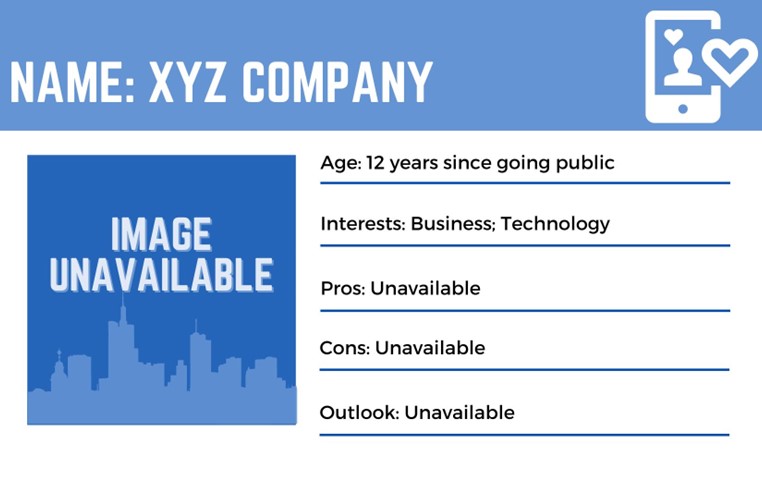Image Credit: Jill Hoffman-Cuyar
Why Investors and Public Companies Rely on Company-Sponsored Research
Would you meet with someone from a dating app if they did not provide a clear photo?
Regardless of how fulfilling the future may have become with the person or how great they may or may not look, statistically, we know, without a clear picture, the person is going to get passed over by all except for the greatest risk takers.
It’s easy to understand why even the least appealing dating site profiles with a clear image will attract more interest than the profile without a clear and updated picture. Similarly, product reviews on Amazon serve the seller. If there are two similar products, one with average reviews and another with no review, consumers are more likely to take a shot at the one with more available information – especially third-party reviews – even if the item has a higher price.
Small, lesser-known stocks also need a clear picture to attract broad attention. The broader the attention, the more potential suitors. This is why companies without a clear picture or without an experienced third-party analysis cause investors to quickly “swipe left.”
A stock with low third-party analysis available doesn’t serve the company well and is frustrating to investors with positions they may not be getting a fair valuation or adequate liquidity on.
Company Research
Equity research and analysis of a company from analysts known for their experience, industry knowledge, and integrity, provide a picture for investors. As mentioned earlier, without a picture, far less attention is paid. Companies with updated research will increase the number of investors looking at their stock because investors will feel they have more insight and understanding.
Company research is different than company information. Publicly traded companies are required to provide quarterly information to the public. This includes most categories of small-cap stocks and microcaps that are traded over-the-counter (OTC) and trading on a regulated exchange. These SEC-required reports provide a basis for investors to look back on company-provided data. When this financial data is compared to historical trends, weighed against industry growth and ratios, then subjected to “what-if” scenarios, the information derived becomes analysis.
To be deemed research, the analysis is put under a spotlight along with evaluating the strength of management, intangible assets such as patents, market positioning, and a variety of other considerations.
Importance for Smaller Companies
Awareness of the investment opportunities smaller companies represent is typically low. The stocks just aren’t talked about in mainstream financial news. For this reason, companies with a low market capitalization can benefit from any quality research published on their companies, their products, and their economic prospects. This is because any publication which provides a heightened understanding of a company may create interest that leads to added liquidity and aids the market’s price discovery of the stocks’ best valuation.
A Relatively New Gap to Fill
In the past, small and micro-cap companies have benefited from coverage at research departments of broker/dealers that had the capacity to provide investor research. The motivation for these research departments to provide in-depth expensive research was often to act as a door opener for other lines of financial business (quid-pro-quo). While this introduced some risk of compromised integrity, the practice of those that sell stocks (sell-side) providing analysis was common.
What could go wrong with investors relying on research from the company that sells the stock that is researched? Everyone involved in the markets in 2002 or who has read up on market history knows the Enron story. Enron was highly rated by sell-side analysts right up until the week the company collapsed. The event suddenly brought the sell-side research “conflict of interest” to the front pages.
The New York Times reported: “Lawmakers investigating the collapse of Enron turned their attention to Wall Street today, criticizing financial analysts for continuing to urge investors to buy Enron stock even as the company headed toward bankruptcy. Several members of Congress suggested that Wall Street firms’ hunger for investment banking business and other conflicts kept them from leveling with investors.” (NYT 2/27/02)
The Wall Street Journal echoed The Time’s sentiment: “Some financial firms have said they felt obliged to participate in the partnerships in order to remain in the running for underwriting assignments from Enron.” (WSJ 2/8/02) “Complimentary” broker/dealer research of smaller companies pose a similar risk, however, when problems occur for investors, they are unlikely to get the attention of large news outlets.
So complimentary research and analysis ran the risk of being partial. And only when a big company failed did the media and lawmakers take notice. This began to open the door to research that was subscribed to and paid for directly by investors. Larger investors that could afford it might still review sell-side research, but the research they paid for was less likely to have an undeserved positive bias.
Reduced Research Available
For small and microcap companies, both the sell-side research and the paid-for research began to get much less interest as investors changed their focus.
One overshadowing reason complimentary small company coverage dropped off and quality paid for research became less sought after by investors is that index fund popularity increased. That is, the popularity of investment funds that are managed with the objective of providing returns mimicking a stock index was being advertised as the ideal way to gain diversified exposure to “the market.” These indexed Mutual Funds (MF) and Exchange Traded Funds (ETF) provide close tracking of an equity index largely by owning the companies within the index. Individual stock selection became less common. This reduced research coverage has shut out companies and particularly hurt those not in a major index. As important, it lessened the number of stock pickers, as many money managers and self-directed investors instead became index pickers.
From the point of view of investors reviewing stocks and looking to get involved with “the next big thing,” there was less information to go by. Arguably worse, there were and are still many companies, some of which literally have life-saving products, that aren’t getting the capital flows they would have to manage their needs.
Company-Sponsored Research
Needs have a way of being filled in an open economy. Active research is still highly needed by those that transact in the microcap and small-cap sectors. And top-tier research coverage is still crucial for small public companies looking to expand their visibility among investors trying to unearth and understand companies. With fewer sell-side firms covering stocks, and subscription based-research attracting fewer subscribers, an evolution took place in how institution-quality research is provided.
Filling the gap left by the large bulge bracket broker/dealers and niche subscription services is what has, over the past few years, become the preferred model of equity research and analysis. Company-sponsored research (CSR) sprang from the need for small companies to again provide a clear picture to investors.
This new model borrowed heavily from the well-established bond market services where firms like Moody’s and S&P provide research and credit analysis on public company debt. CSR providers were able to hire the very best analysts released by the big sell-side shops, and in some cases, subscription-based services converted to the CSR model. The institutional quality research is now compensated by the company that knows it will benefit from an unbiased evaluation from respected analysts. This new practice eliminates the past conflict of interest of investment analysts that may have experienced pressure to err on the side of a favorable outlook to help smooth the way to additional higher-paying services from the client.
A few of the research firms providing company-sponsored research to companies have taken an additional measure. These firms are requiring their analysts to pass FINRA (Financial Industry Regulatory Authority) qualifying exams in order to become registered securities professionals. The exam(s) and ongoing continuing education required to maintain the professional registrations, ensure a high level of understanding, further promotes ethical behavior, and provide for punishment, including loss of career, if some guidelines are not adhered to.
This new standard in who provides research and who it is available to clearly benefits the professional investor who may have always had access. But some firms providing company-sponsored research now make it available to all investors of any size. This was most often not the case as sell-side broker/dealers often only allowed timely access to their buy-side customers, and subscription services were too pricey for small investors.
The largest CSR provider in the U.S. and Canada today is the research provided by analysts at Noble Capital Markets on a no-cost investor platform Channelchek and various subscription platforms used by institutional investors.
Take Away
Investing goes through regular incarnations and reinventions. The use of technology has provided an environment where passive investing gained in popularity. Just as other trends in investing have fallen out of favor, disruption or innovation will one day turn the tide toward another trend. Fortunately, some of the research activities that have been dropped by the sell-side broker/dealers, effectively decreasing resources to their customers, have been replaced with company-sponsored research. This evolution is growing in appreciation by both those raising capital and those investing assets.
Investors in companies covered by CSR have the benefit of an additional pair of trained eyes on companies they own, the companies benefit from not being overlooked from lack of coverage, and the world benefits as companies that will provide tomorrow’s life-saving drug, mining discovery, medical apparatus, storage innovation, or anything else may now better rely on being able to tap into capital and liquidity.
Managing Editor, Channelchek
Suggested Content
 Has the Bear Market Left a Permanent Mark on Indexed Investments?
|
 Why Researching Investment Ideas is Important
|
 Is Quantitative Tightening Impacting the Economy on the QT?
|
 Should Investors Listen to Influencers?
|
Sources:
https://www.cnbc.com/2019/03/19/passive-investing-now-controls-nearly-half-the-us-stock-market.html
https://www.morningstar.com/news/dow-jones/201909182571/index-funds-are-the-new-kings-of-wall-street
Stay up to date. Follow us:

|
